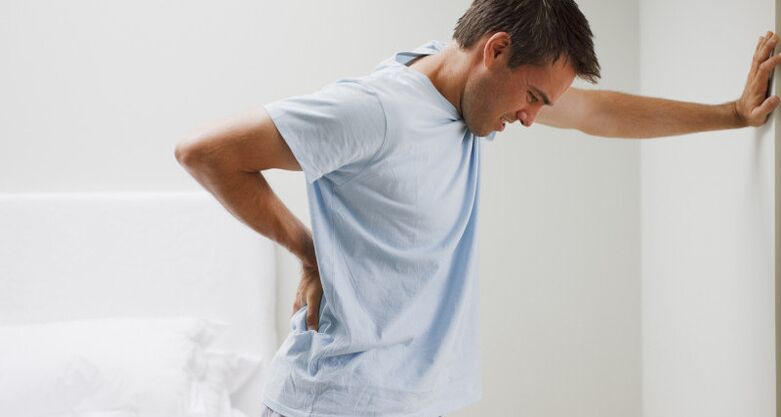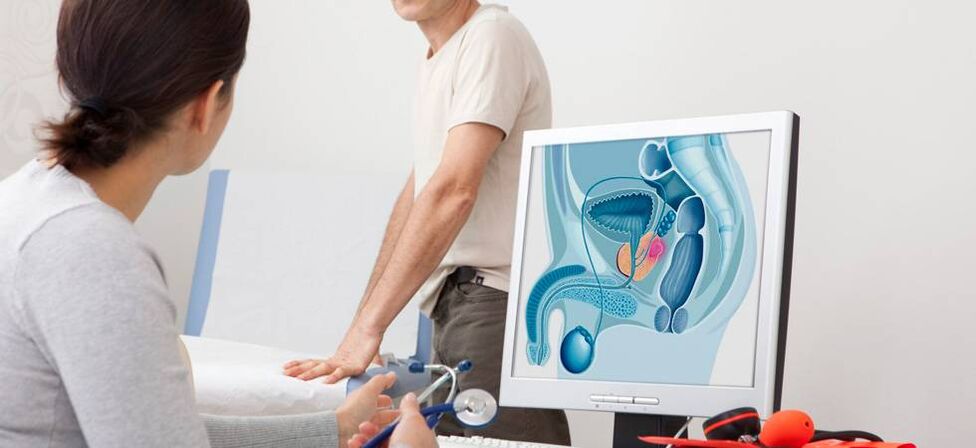The pathology of the prostate gland, which develops due to inflammatory processes, is called prostatitis as disease - prostatitis.
The development of pathology
Mostly an infectious form of prostatitis occurs. The infection that the prostate can impress by penetrating from the urethral hole or other organs and glands of the Genitourary system.
The high probability of an infection of the organ is due to the adjacent localization of the anus and urethra canal.
With this probability, statistics recognize inflammatory inflammation of the prostate in men, which is associated with the suitability of the organ for infected neighbors.
Even the presence of an infection in the prostate does not ensure the development of inflammation.
Inflammation of the prostate occurs with the common effect of pathogenic microorganisms and provocative factors.
The causes of prostatitis
Every man who has surprised or inevitable the disease based on the tightening of provocative factors can guess the course of prostatitis.

The prostate gland is a place for the transit of the urethral canal. Therefore, the inflammatory process in a sick organ that leads to an increase in its structures leads to a violation of the emptying of the bladder.
When creating a diagnosis for different forms of inflammation of the prostate gland, the binary nomenclature is used:
- Chronically not infectious
- Chronically contagious
- Acute contagious
- Acute not -infectious
Varieties of prostatitis are due to a complex of provocative factors under certain circumstances.
The first factor that is statistically in men of young and prefabricated old age - infections that are transmitted by the sexual partner.
Venus diseases, especially at the stage of symptomatic remission, can leave an infection in a hidden state or prostate lesions, which progress also after eliminating an infectious active ingredient.
Infection can complement the infection, systematic excessive diet, the diet of acute, excessively oily carbohydrate foods.
In this way, infectious prostatitis does not occur and the course of a non -infectious variety is improved.
Provocation factors are hypothermia and changes in age in the prostate.
Signs of prostatitis in men
It is difficult to diagnose an infectious or non -infectious form of inflammation of the prostate, which is only based on the similarity of the symptoms.
If the following signs of prostatitis are determined, a comprehensive diagnosis of methods to recognize the disease must be carried out:
- During emptying the bladder, pain and intensity are experienced after the urination ends that the patient has a burning feeling in the urethra.
- Body temperature via normality;
- The feeling of incomplete emptying of the bladder after the end of the urination does not leave the sick man for some time;
- Pain in the period between urination can be felt in the perineum, in groin and abdominal zones, which reflect in legs, buttocks, pelvis and sacrum;
- Lethargy and discomfort.
A man can suspect prostatitis if at least two of them become noticeable from the entire list and the symptoms.
A specific sign of the inflammatory process in the prostate is the temperature difference, which is measured in different parts of the body.
The pattern of temperature changes is associated with the localization of the focus of the inflammation: the closer to it, the higher the temperature.
When measuring the temperature in the oral cavity, deviations from the norm are not observed in the armpits - a subfebrile temperature, in the rectum the parameter value exceeds the norm greater than one degree.
The pain symptom develops with increasing intensity with increasing inflammation of the prostate.
The typical event of pain is characteristic of the process of emptying the bladder, during the day the pain extends to the rectum and the entire area of the perineum.
The pain intensity takes with a small to unbearable.
Purder and discomfort can be accompanied by dizziness and headache, small nausea attacks and sleepiness.
If such symptoms are determined, a urine delay is suspected, whereby the general poisoning of the body is developing protein decay products.

Deviations in urination are not associated with the inertia of the jet, a long drip release of urine, not the impending formation of a jet and emptying the bladder in the absence of a urine release.
Possible complications
Complications after prostatitis occur without medical intervention in the course of the disease or inappropriately a treatment scheme.
Medical practice shows the most common distribution according to prostatitis:
- Lack of erection and ejaculation;
- the spread of the inflammatory process to the nearby organs of the genitarian system;
- Cytological disorders that lead to the inability of sperm fertilize the eggs;
- Acceptance of libido;
- Psychoneurotic states that reduce the quality of life and the health of a man as a whole.
According to prostatitis, the penis reduces the ability to harden and meet blood. Possible sexual contacts end compared to the recent full sex life. Not every sexual contact ends with ejaculation.
If such deviations are found, a comprehensive diagnostic test is required.
With the spread of the inflammatory process to urethra and bladder, bladder inflammation and urethritis develop.
With the development of the latter, the pain of sharp nature appears that the process of impaired urine outflow (its delay or incontinence) changes to a chronic level. A man's performance in this state is doubtful.
Erectile dysfunction leaves a number of psychological and therapeutic problems that require competent medical correction.
The impossibility of being filled with blood is explained by the edematous state of the prostate and the associated genitarian organs.
The blood supply to the penis, which is necessary for an upright state, becomes problematic.
Psychologically, the third part of men who were developed according to consequences after prostatitis suffers in a severe form.
The condition of a man can only normalize itself against the background of drug therapy during long -term psychological work. Failures in sexual life hinder the further wish to continue sexual life.
Prostatitis can cause a violation of the acid base composition of sperm, which is reflected on the fertilizing capacity of sperm.
The result of the pathology is infertility in a man of the first degree. In this state, it is important to eliminate the cause of infertility in good time, since the possibility lacks to cure the infertility of the second degree using a drug process. Proper treatment can be prescribed by the Andrologist or urologist. Therefore, men should not ignore the signs of prostatitis.
Diagnosis
The diagnostic examination scheme depends directly on these symptoms and signs with which the patient appeals to the urologist or andrologists.
The diagnosis of prostatitis in men can be carried out both at home and in a medical facility.
The first diagnostic phase is data acquisition for an anamnesis. The doctor carries out an external inspection of the genitals and listens to the patient's symptoms.
Based on the initial data, a scheme of the further diagnostic examination of a sick man is determined.
During the accumulation of an anamnesis, the doctor determines the duration of the symptoms that occurred, the presence of prostatitis shown beforehand, a list of diseases by the patient, risk factors for the development of the disease, a possible list of transmitted sexually transmitted diseases, the development of signs of illness, the presence of sexual partners and sexual relations.
In the current phase of the development of medicine, the list of questions in the questionnaire is published that the patient fills out before visiting the doctor's office. This saves the time of the patient and the doctor.
The patient's first mandatory examination stage with signs of prostatitis is the examination of the prostate gland from the rectum.
The doctor determines the degree of the increase in the inflamed organ, its density, the uniformity of the consistency or the presence of nodes or seals, the degree of pain during palpation.
The intestinal cavity is carried out before the palpation.
In the absence of an inflammatory process in the prostate, there is no pain, the intensity of the pain can vary in prostatitis, and its localization can be felt in the groin, rectum, in perineum and in the sacrum. In this case it is contraindicated in a number of procedures, e. g. B. cystography.
For a microscopic examination of the secretion of the prostate, the patient is carried out by the rectum by massage of the prostate.
With the desire to urinate until the end of the prostate massage, this can only be done until a drop of the prostate secretion from the urethra opening is used for analysis.
The process ends with the implementation of the subject glass of the microscope along the hole of the urethra, according to which the smear is painted according to the following parameters and analyzed microscopically:
- the presence of leukocytes and the calculation of their amount;
- Lecitin amount;
- The activity of pathogenic microorganisms and their presence.

The detection of bacteria in the visual area of the smear shows the infectious type of prostatitis.
The number of leukocytes in the field of more than 2 shows the inflammatory process in the prostate.
For a reliable result of a microscopic examination, it is necessary to correctly take a fence for the analysis and to paint the medication competently.
The above tests are mandatory, additional examinations are selectively prescribed by the doctor, depending on the suspicion of doctor on the type of inflammation.
The urethra's secret is analyzed by a tool similar to a catheter. Wool is wrapped on the metal coating.
Before the analysis is adopted, urination is excluded for 2-3 hours. Otherwise, microflora is washed into the outer environment.
The doctor introduces a cotton smear of approximately 4 cm in the hole of the penis and makes rotation movements. A smear from the urethra is examined for the presence of DNA and bacterial residues.
The analysis of the urine is a means of detecting blood cells: red blood cells and leukocytes, protein (normally missing or in trace quantities).
In the event of errors in the analysis of the symptoms of urethral and prostatitis, urine sowing is prescribed for bacteriological analysis.
The disadvantage of the method is the long -term expectation of a colony of pathogenic microorganisms (up to 1 week).
The sowing takes place using a comparative method according to the fence of three parts urine (start, middle and end of the bladder emptying).
A larger number of pathogenic microorganisms in one of the samples gives the basis for the acceptance of the localizing focus of infection.
The proof in the first part of the urine of bacteria gives no reason to confirm the inflammation.
The second and third part of the urine, which goes beyond the number of recognized microorganisms, form the basis for clarifying the localization of inflammation (in the urethra or the bladder).
The degree of deviation of the sexual function of the norm is rarely prescribed by analyzing sperm on viscosity and other physical-chemical indicators for the environment, the activity and livelihood of male gamets and a sperm.
The Urofloometric method is not often arranged. If the possibility and addition of the image of the changes take place, an urodynamic examination of the urinary tract is carried out.
An ultrasound examination determines the density of the sick organ and other parameters, which were obtained from the rectum after a finger examination of the prostate.
The prostate gland is visible in two ways: transectal ultrasound and ultrasound through the abdominal cavity.
In the event of suspicion of adenoma and prostate cancer, the doctor can prescribe an additional cytoscopic examination of blood, the so -called dog test.
The fence is made from a vein, a blood test determines the presence of RSA protein (excludes), which occurs with malignant tumors.
Zu Hause kann der Patient die Prostatitis vermuten und sich auf die Farbe und Trübung des Urins und die Symptome der Krankheit konzentrieren.
Wie man zu Hause behandelt
Versorgung mit Arzneimitteln
If there are signs of prostatitis, men should not be mediated themselves, medication should only be prescribed by a doctor.
Präparate zur Heilung von Prostatitis werden durch eine Vielzahl von Formen und pharmazeutischen Eigenschaften unterschieden. Meistens werden vorgeschriebene Kerzen für den rektalen Gebrauch vorgeschrieben.
The reason for the selection of doctors is associated with the proximity of the effects of the components of rectalic acids and the prostate gland.
The disease for the effective effect of the active substance of candles on the organ tissue is the peace of the patient in a lying position after administering the rectal drug. Kerzen inaktivieren pathogene Mikroflora und haben einen analgetischen Effekt.
Intramuscular and intravenous injections contribute to the fastest effect on the sick organ by spreading through the bloodstream.
Immediately after urination, the instillations will aim to penetrate into the prostate through the urethra hole. Die maximale Verabreichung beträgt 5 ml.
Table forms for prostatitis are better known as antibiotics that are divided into 3 groups and successfully dealt with the possible spectrum of types of pathogenic microflora:
- Tetracycline
- Fluorchinolone
- Penicillins
In the evening, warm microclisms are carried out with inserted substances.
The main condition for the use of the enema is the inadmissibility of the glandular tribe and compliance with the temperature regime. Refers to folk methods for the treatment of prostatitis.



























